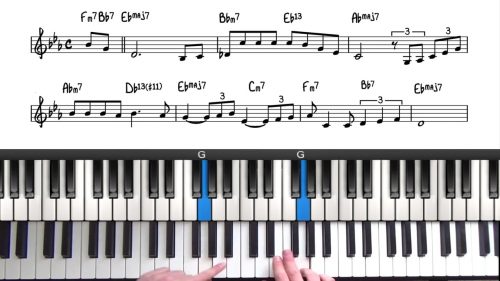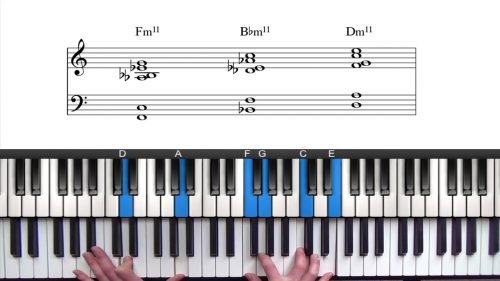Adding Chord Extensions To “Misty”
In this lesson we introduce chord extensions into our voicings for the A Section of the tune Misty.
In the previous lesson we created 2-handed spread voicings using just the primary chord tones which are the root, the 3rd, the 5th, and the 7th. This is very much the foundation of the harmony and it helps us to clearly visualise the voice leading of 7ths falling to 3rds in 251s.
We are now we are going to add the chord extensions 9ths, 11ths, and 13ths, to create richer, more sophisticated sounding voicings.
What Are Chord Extensions?
Chord extensions include the 9th, 11th, and 13th and these tones can be added to our R-3-7 voicings to create richer and more sophisticated sounds. Chord extensions immediately make your jazz piano playing sound more interesting and professional.
Chord extensions are always added below the melody note so not to interfere with the melody of the tune. In this lesson we work through each chord individually to explore our options when adding chord extensions to the harmony.
Chord Extensions For Major Chords
The first line of “Misty” contains 2 major chords: Ebmaj7 and Abmaj7. For both of these chords we learn how to add the 9th and the 13th below the melody to create a richer sounding chord. The natural 11th cannot be added into major chords becuase it creates a half step clash with the major 3rd.
Chord Extensions For Minor Chords
For minor chords we can apply the 9th, 11th, and 13th which gives us many voicing options. A nice place to start is to add the 9th of the chord, usually tucked underneath the minor 3rd. We can also experiment with the Herbie Hancock Voicing, the So What Voicing, and the Kenny Barron Voicing.
Chord Extensions For Dominant Chords
Similar to the major chord extensions, the 9th and 13th work best over dominant chords. As outlined in the lesson, the chord extensions will sometimes be present in the melody itself. For dominant chords we can also apply chord alterations as we will explore in the upcoming lessons.
Study the process used to identify the chord extensions and apply this method to other tunes that you are working on.
Lesson Downloads
-
Extended Voicings Notation File Type: pdf
Practice Tips
-
If you are just starting out with jazz piano then the theory and the voicings covered in this lesson may be new to you.
-
If this is the case then just copy the demonstrations to familiarise your fingers and ears with the shapes and sounds of extended chord voicings.
-
Watch the theory lessons in our chord extensions beginner course where all of this theory is explained in detail. See the related lessons above.
-
Understanding what chord extensions are and where they come from is an essential step before the next lesson where we introduce a stride left hand style with rootless voicings.








This is great Hayden – really well done and easy to follow. At the end of the lesson, though, you promise a transcription, but I don’t see it. That’d be super useful to have. Overall this is an excellent series of lessons, and more like this on other standards would be fantastic, when you get time.
Hi Jane,
I’m glad you are enjoying the lessons.
Yes please excuse the delay with the PDF files, they are being created as we speak and they will be added to each lesson page shortly. Our transcriber is creating PDF files of the demonstrations for all lessons in both the harmony and the improvisation module. I have just emailed him and hopefully he can send me the lessons he has finished so far.
Finally yes I am in the process of creating another course like this for the tune “In A Sentimental Mood” – more updates on this to follow :–)
Cheers,
Hayden
Thanks Hayden, that’s great, and looking forward to Sentimental Mood too!
Hi Hayden,
Now as a new subscriber I can say that I make some progress with this course.
I have now studied and understood the extensions. What I still don’t understand is in which situation is which extension appropriate? Are there some simple rules for this?
Best regards
Jochen
Hi Jochen,
I’m glad to hear on your progress.
Adding extensions is largely down to personal taste. As we explored in the earlier lessons, we can play the tune with simple voicings containing just roots, 3rds and 7ths which are the essential components of the harmony.
Chord extensions – and chord alterations we explore in the upcoming lessons in this module – are used to create more complex and interesting sounds which is one of the main characteristics of jazz music. There is no ‘set-in-stone’ rule on when to use them. They are optional additions which you can include in your voicings at your discretion.
Often you will notice that extensions are already built into the melody, for example in the 2nd bar, we have the 9th in the melody over the Bb-7 chord (the note C) which then becomes the 13th of the Eb7 chord when the chord changes half way through the bar. So by playing a simple R-3-7 voicing underneath, you are already playing extended chord voicings.
The exact same thing happens in the 4th bar when we have the note Bb in the melody (the 9th of Ab-7) which then becomes the 13th of Db7 when the chord changes half way through the bar.
One important point is that generally speaking, we don’t add extensions above the melody note, because the melody note should be the highest note, and so usually we try to add the extensions somewhere inside the chord to keep the melody note ‘intact’ and the melody of the song recognisable.
The best way to gain an appreciation of where extensions and alterations are appropriate is to learn to play lots of jazz standards. Start by copying and emulating the demonstrations in these courses and you will start to spot patterns and common situations where extensions are used.
As mentioned at the start, a lot of this is down to personal taste, and naturally you will like the sound of some extended voicings and altered voicings more than others. Make a mental note of these and apply them in other tunes and slowly and gradually this becomes part of your own style when you play jazz piano.
It might be nice for you to review the theory lessons in our chord extensions course:
pianogroove.com/jazz-piano-lessons/extended-chords-voicings/
This covers a selection of useful extended voicings, the extended 251 progression, and also practice drills to learn and visualise chord extensions in all 12 keys.
A related area is altered harmony which you can find in this course: pianogroove.com/jazz-piano-lessons/altered-harmony-upper-structure-triads/
I hope that helps Jochen – to summarise, start by copying and emulating the demonstrations to familiarise yourself with the sound and shape of extended chord voicings, and also study our other jazz standard courses and you will quickly see that the same voicing shapes and formulas can be applied in many different settings.
If you have any further questions just let me know.
Talk soon, cheers,
Hayden
We’re learning so much from you! Hayden, Thank you! I love how you showed the possibilities we can do when playing to Fm7-Bb7 and Gm7 progression. 😊
Thanks Maria – I’m glad the lessons are insightful.
I hope you are well and talk soon! :–)
Hayden